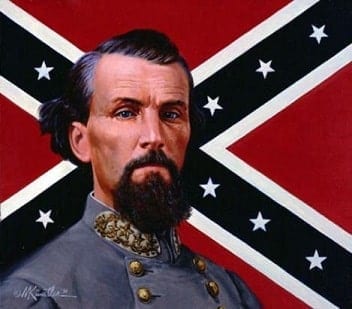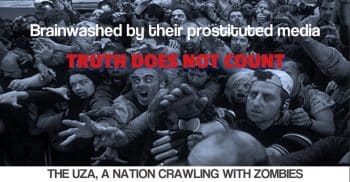While it may be tempting to dismiss 500 knuckle-dragging racists marching through Charlottesville waving Confederate flags as unrepresentative of a nation that takes pride in values of tolerance and racial equality, it would be wrong. Those who took part in those ugly scenes are the reality rather than the myth of America. They know that the American exceptionalism which Obama, while president, declared he believed in with every fiber of his being, is in truth white exceptionalism – ‘white’ in this context being not only a racial construct but also a political and geopolitical construct.

Memphis, Tenn. statue honoring Lt Gen Nathan Bedford Forrest, reputed to have been a founder or early member of the KKK, and one of the most controversial figures in the CSA army. To this day the state boasts more statues of Forrest than any other hero of the state of Tennessee.
Indeed, Obama’s election as the nation’s first black president, rather than heralding the post racial society the country’s liberal establishment liked to believe, merely confirmed the extent to which the generations-long struggle for black liberation and emancipation did not end in victory but in defeat – a defeat reflected in Obama and his supporters’ embrace of the very institutions that have violated and crushed the humanity of black and brown people in the land of the free since time immemorial.
While the US Confederacy, which was the Islamic State of its time, was defeated on the battlefield, racial oppression remained the lived experience of the newly freed slaves and remains the lived experience of their descendants today. Consider for a moment the withering j’accuse delivered by Frederick Douglass, escaped slave and towering figure of the country’s abolitionist movement in the mid 19th century. In a speech he gave in 1852 to mark that year’s Fourth of July, the most sacred and revered anniversary in the US calendar, Douglass reminded his audience that your celebration is a sham; your boasted liberty, an unholy license; your national greatness, swelling vanity; your sounds of rejoicing are empty and heartless; your denunciation of tyrants brass-fronted impudence; your shouts of liberty and equality, hollow mockery.
While no longer held in bondage, the plight of African-Americans today – who make up a disproportionate number of victims of police violence, who make up a disproportionate number of the country’s burgeoning prison population, who are most likely to be unemployed and under-employed, most likely to be living in substandard and insecure housing conditions, and least likely to receive a college education – the harsh sentiment underpinning Douglass’s words is one his descendants would be justified in sharing with him 165 years later.
Yet even though Obama spent his two terms in the White House going out of his way to cloak the snarling beast of US exceptionalism and its white supremacist roots in the garb of democracy, he was not embraced by those who prefer their coffee white. Here it is impossible to avoid the fact that Trump’s election was in large part a reaction to Obama’s race as much as it was to his policies.
If you do not believe me then what, pray tell, is the so called alt-right, the ideological foot soldiers of Trump’s election campaign and his political base, if not a movement of unreconstructed reactionaries and racists for whom white is right and the likes of legendary Confederate army general, Nathan Bedford Forrest, is lauded as a heroic figure who epitomizes the valor and romanticism of the losing side in the US Civil War?

Gen. Forrest was a man of humble origins who had made himself into one of the richest men in the South by the time the Civil War started. A plantation owner, he was also a prominent slave trader.
The veneration in which Forrest is held 150 years on is evidenced in the annual commemoration of his birthday in his home state of Tennessee, known as Nathan Bedford Forrest Day. It is also reflected in the statue of him which today sits pride of place in a park in downtown Memphis. And his is just one of the plethora of statues, monuments, and commemorations that celebrate and seek legitimize the US Confederacy across the South. These monuments and statues are, by the way, a relatively recent phenomenon, with many of them dating back to the 1960s, when they were erected as a reaction to the Black Civil Rights Movement, a movement which at the time was a threat to the racist culture that held sway, and still holds sway, in many of the former Confederate states.
In truth Nathan Bedford Forrest was a racist, murdering savage who after the war became the first Grand Wizard of the Klu Klux Klan. He fought for the ignoble cause of slavery and white supremacy, along with every other soldier of the Confederacy, and as such his statue is an insult to any conception of human decency. It is, indeed, comparable to a statue of Reinhard Heydrich or any other Nazi leader sitting pride of place in downtown Munich.
The ugly scenes that took place in Charlottesville, Virginia did so in response to a decision by the city’s authorities to remove a statue of that other famed confederate general, Robert E Lee, from a park there. Those scenes and the controversy surrounding the memorials, statues and monuments in tribute to the US Confederacy are proof that the Civil War never really ended – and certainly not in the victory for the forces of anti-slavery and racism that history would have us believe.
Ultimately, it will take more than the removal of a few statues and monuments to eradicate the cancer of white supremacy in America. It will take nothing less than the eradication of the very idea of America itself.
Addendum Nathan Bedford Forrest (July 13, 1821 – October 29, 1877), called Bedford Forrest in his lifetime, was a lieutenant general in the Confederate Army during the American Civil War. Forrest was accused of war crimes at the Battle of Fort Pillow for allegedly allowing forces under his command to massacre hundreds of black Union Armyand white Southern Unionist prisoners. However, Sherman investigated the allegations and did not charge Forrest with any improprieties. Nathan Bedford Forrest was born to a poor Scotch-Irish American family in Bedford County, Tennessee. He and his twin sister, Fanny, were the two eldest of blacksmithWilliam Forrest's 12 children with wife Miriam Beck. The Forrest family had migrated to Tennessee from Virginia, via North Carolina, during the second half of the 18th century, while the Beck family had moved from South Carolina to Tennessee around the same time.[8] After the deaths of his father and Fanny to scarlet fever, Forrest at age 17 became head of the family. In 1841, Forrest went into business with his uncle Jonathan Forrest in Hernando, Mississippi. His uncle was killed there in 1845 during an argument with the Matlock brothers. In retaliation, Forrest shot and killed two of them with his two-shot pistol and wounded two others with a knife which had been thrown to him. One of the wounded Matlock men survived and served under Forrest during the Civil War.[9] Forrest became a businessman, planter, and slaveholder. He owned several cottonplantations in the Delta region of West Tennessee. He was also a slave trader, at a time when demand was booming in the Deep South; he had his trading business based on Adams Street in Memphis. In 1858, Forrest (a Democrat), was elected a Memphis city alderman.[10] Forrest supported his mother and put his younger brothers through college. By the time the American Civil War started in 1861, he had become a millionaire and one of the richest men in the South, having amassed a "personal fortune that he claimed was worth $1.5 million".[11] Before the Civil War, Forrest was well known as a Memphis speculator and Mississippi gambler. He was for some time captain of a boat which ran between Memphis, Tennessee and Vicksburg, Mississippi. As his fortune increased he engaged in plantation speculation, and became the nominal owner of two plantations not far from Goodrich's Landing, above Vicksburg, where he worked some hundred or more slaves ... He was known to his acquaintances as a man of obscure origin and low associations, a shrewd speculator, negro trader, and duelist, but a man of great energy and brute courage.[12] The source for this excerpt is Wikipedia.
 A cavalry and military commander in the war, Forrest is one of the war's most unusual figures. Although less educated than many of his fellow officers, before the war Forrest had already amassed a fortune as a planter, real estate investor, and slave trader. He was one of the few officers in either army to enlist as a private and be promoted to general officer and corps commander during the war. He created and established new doctrines for mobile forces, earning the nickname The Wizard of the Saddle.[3] In their postwar writings, Confederate President Jefferson Davis and General Robert E. Lee both expressed their belief that the Confederate high command had failed to fully use Forrest's talents.[4]
A cavalry and military commander in the war, Forrest is one of the war's most unusual figures. Although less educated than many of his fellow officers, before the war Forrest had already amassed a fortune as a planter, real estate investor, and slave trader. He was one of the few officers in either army to enlist as a private and be promoted to general officer and corps commander during the war. He created and established new doctrines for mobile forces, earning the nickname The Wizard of the Saddle.[3] In their postwar writings, Confederate President Jefferson Davis and General Robert E. Lee both expressed their belief that the Confederate high command had failed to fully use Forrest's talents.[4]
 John Wight is the author of a politically incorrect and irreverent Hollywood memoir – Dreams That Die – published by Zero Books. He’s also written five novels, which are available as Kindle eBooks. You can follow him on Twitter at @JohnWight1
John Wight is the author of a politically incorrect and irreverent Hollywood memoir – Dreams That Die – published by Zero Books. He’s also written five novels, which are available as Kindle eBooks. You can follow him on Twitter at @JohnWight1
 John Wight is the author of a politically incorrect and irreverent Hollywood memoir – Dreams That Die – published by Zero Books. He’s also written five novels, which are available as Kindle eBooks. You can follow him on Twitter at @JohnWight1
John Wight is the author of a politically incorrect and irreverent Hollywood memoir – Dreams That Die – published by Zero Books. He’s also written five novels, which are available as Kindle eBooks. You can follow him on Twitter at @JohnWight1 While it may be tempting to dismiss 500 knuckle-dragging racists marching through Charlottesville waving Confederate flags as unrepresentative of a nation that takes pride in values of tolerance and racial equality, it would be wrong. Those who took part in those ugly scenes are the reality rather than the myth of America.
![]() [premium_newsticker id=”154171″]
[premium_newsticker id=”154171″]





Sticks and Stones…. It is amazing to see once again so many white liberals and bourgeois leftists claiming in script: “mea culpa” and becoming “plus noir que les noirs….”. From absurd claims to eradicate the USA itself which would harm workers more than help, to the moral indignation so smartly indicted by Bohne elsewhere on this site, little is ever said about a clear program to move forward toward change. In fact, it is quite insulting to side with the oppressed classes on race differences and black revolutionaries reject that kind of hypocrisy. It is not and never can be… Read more »